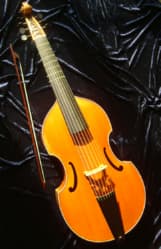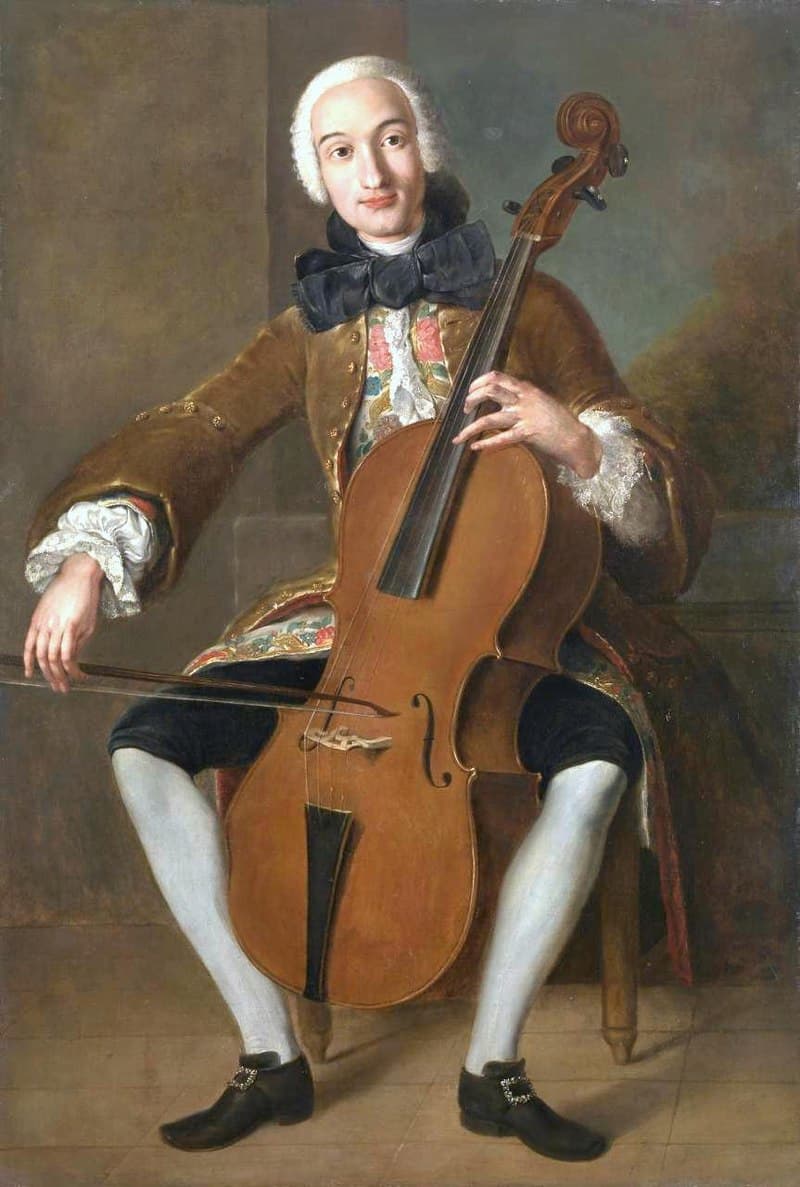The bigger brother of the violin and viola, the violoncello actually has two different names hidden in its name: it starts with viol (like violin and viola) and then has the Italian ending -one, meaning big, and ends with the Italian diminutive of -ello, making it the little big viol.
In its original versions, it was called the bass violin and it wasn’t until the 18th century that the name ‘violoncello’ was attached to the instrument.
The parallel instrument to the cello was the viola da gamba, or the viol played for the leg (versus the viola da braccio, the viol for the arms, which became the violin). A cello has a curved back, the viola da gamba has a flat back. The rounded shoulders of the cello are sloped in the viola da gamba and its f-holes are c-holes.

Violoncello or cello

Viola da gamba (Uilderks)
Although makers in Cremona had made cellos before him, it is Antonio Stradivari who is given the credit for standardizing and perfecting the form of the cello before 1700. Composers recognized the need for different kinds of bass instruments: ones with thin strings for solo work and ones with thick strings for orchestral work. As Stradivari’s smaller cello design became the norm, older, larger instruments were often cut down and altered by changing the body dimensions, the neck, the fingerboard, and so on.
The cello is played vertically in front of the body. At first, it was held with one leg. J.-L. Durport (ca.1806) that the player had to sit ‘very far forward on a chair with the left foot forward and the right drawn back so that the left-hand corner of the cello falls into the hollow of the right knee with the weight of the cello resting against the left leg. The right leg steadies the instrument against the lower right side of the cello’. Other writers cautioned against slumping, bending the body too far forward, or raising one’s elbows or shoulders too high.
The physical price of playing the cello can be seen in the 1993 autopsy of the virtuoso cellist Luigi Boccherini (1743–1805) found many deformities in his skeleton because of his cello playing, including advanced arthritis in his bow hand, particularly at the base of his thumb. His left elbow had been chronically inflamed (what we would call ‘tennis elbow’ today). The upper third of his shins were deformed from gripping the instrument and because of the uneven stress on his body, the left side of his body showed distortion of his vertebrae from his neck down to his spine. The pressure of the cello’s body on his chest caused ossification on both sides of his sternum and his ribs.

Pompeo Batoni: Luigi Boccherini playing the violoncello, ca 1767 (National Gallery of Victoria)
The sound of the cello, for many composers, is the sound of melancholy. Starting with J.S. Bach’s suites for solo cello, the voice of the cello is a unique signature of its presence.
Bach’s suites are tests for the cello in lyricism, dance music, and virtuosity in playing.
J.S. Bach: Suite for Solo Cello No. 1 in G Major, BWV 1007 – I. Prelude (Valérie Aimard, cello)
Vivaldi doubled the effect in his concerto for two cellos. One of his innovations in the concerto was to omit the orchestra in the slow movement, leaving only the two soloists to play as if for a sonata, rather than a concerto, with the continuo below for support.
Antonio Vivaldi: Concerto for 2 Cellos in G Minor, RV 531 – II. Largo (Julian Lloyd Webber, Jiaxin Lloyd Webber, cellos; European Union Chamber Orchestra; Hans-Peter Hofmann, cond.)
Beethoven’s encounter with the cello was profitable. His new opus 5 cello sonatas, played at the court of Potsdam in 1787 before the cello playing Freidrich Wilhelm II, nephew of Frederick the Great, resulted in the presentation to Beethoven of a golden snuffbox filled with gold coins. Beethoven’s Sonata in A major, Op. 69, written for the cello-playing friend Baron Ignaz von Gleichenstein, opens with the cello in its lower register. In the Scherzo, the piano moves to the low register while the cello takes the upper part.
Ludwig van Beethoven: Cello Sonata No. 3 in A Major, Op. 69 – II. Scherzo: Allegro molto (Maria Kliegel, cello; Nina Tichman, piano)
Chopin’s Cello Sonata in G Minor, written in 1846, was the only work by this virtuoso pianist that gave virtuoso attention to another instrument. He worked the hardest and longest on this score, reporting in October 1846 that ‘Sometimes I am happy with it, sometimes not. I throw it in the corner and then pick it up again’. It was a difficult time for Chopin – his relationship with George Sand was failing and his health was disintegrating. The work was given its premiere by Chopin and his friend the cellist Auguste Franchomme in February 1848 in Chopin’s last concert in Paris.
Frédéric Chopin: Cello Sonata in G Minor, Op. 65 – II. Scherzo (Allegro con brio) (Torleif Thedéen, cello; Roland Pöntinen, piano)
Sergei Rachmaninoff wrote his cello sonata for his cellist friend Anatoly Brandukov. The two played the premiere performance in December 1901. The piano part, in the hand of virtuoso pianist Rachmaninoff, is just as challenging as the cello part and, instead of intertwining, they are each given alternate positions in the spotlight to shine.
Sergei Rachmaninoff: Cello Sonata in G Minor, Op. 19 – I. Lento – Allegro moderato (Steven Doane, cello; Barry Snyder, piano)
In Camille Saint-Saëns’ Carnival of the Animals, the beautiful melody is given to the swan and the cello comes to the fore, the work becoming one of the wintergreen melodies for the instrument.
Camille Saint-Saëns: Carnival of the Animals: XIII. Le Cygne (The Swan) (arr. T. Hodge for cello, harp and cello ensemble) (Sheku Kanneh-Mason, cello; Katherine Thomas, harp; cello section of the City of Birmingham Symphony Orchestra)
Composed as a memorial work for the cellist daughter of some friends, British composer Howard Goodall’s And the Bridge is Love takes its inspiration from Thornton Wilder’s novel The Bridge of San Luis Rey, and its concluding idea ‘But soon we will die, and all memories of those five will have left Earth, and we ourselves shall be loved for a while and forgotten. But the love will have been enough; all those impulses of love return to the love that made them. Even memory is not necessary for love. There is a land of the living and a land of the dead, and the bridge is love. The only survival, the only meaning’. And so this beautiful new piece, completed in 2008.
Howard Goodall: And the Bridge is Love (Julian Lloyd Webber, cello; English Chamber Orchestra; Julian Lloyd Webber, cond.)
When we mentioned above about the use of the cello for melancholic music, one of the most important uses in pop music was in The Beatles’ 1966 song Eleanor Rigby.
The Beatles – Eleanor Rigby (From “Yellow Submarine”)
The cello sings and cries and we shiver and draw close to the emotion.
For more of the best in classical music, sign up for our E-Newsletter

